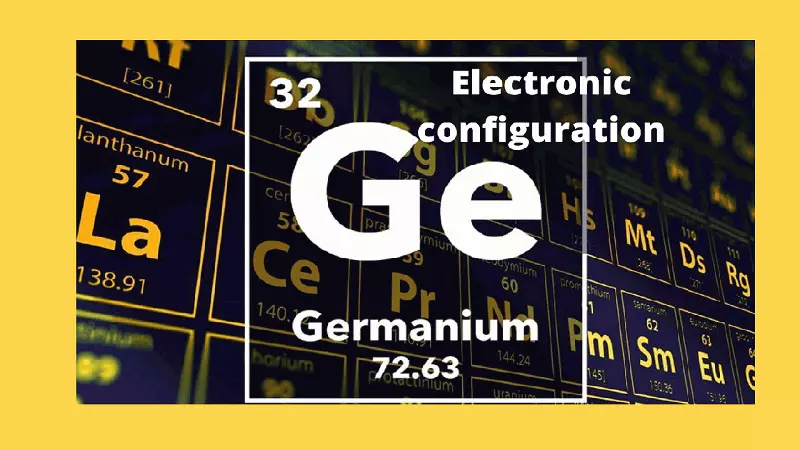
What is Germanium? Electron configuration, Atomic number & Mass
In this article we are going to cover all the information regarding germanium element. Germanium symbol is Ge and you will know about Germanium electron configuration, atomic number & mass as well as its oxidation states, valency and properties, so let’s start with-
What is Germanium?
Germanium is a chemical element with atomic number 32 in the Periodic Table of the elements. The name of the element germanium derives from the Latin "Germania" meaning Germania. Indeed, this element has been identified in Germany. The name germanium was proposed by its discoverer as a tribute to his country.
General informations of Germanium |
|
|
Germanium Symbol |
Ge |
|
Atomic number of Germanium |
32 |
|
Family |
Metalloid |
|
Group |
14 |
|
Period |
4 |
|
Block |
p |
|
Volumic mass |
5.323 g.com-3 |
|
Hardness |
6 |
|
Color |
Grey White |
Atomic properties of Germanium |
|
|
Atomic mass of Germanium |
72.64 u |
|
Germanium Atomic radius |
125 pm |
|
Electronic configuration of Germanium |
[Ar] 4s2 3d10 4p2 |
|
Electrons by energy level |
2 | 8 | 18 | 4 |
|
Oxide |
Amphoteric |
|
Crystal system |
Cubic diamond |
Physical properties of Germanium |
|
|
Ordinary state |
Solid diamagnetic |
|
Fusion point |
938.25 ° C |
|
Boiling point |
2,833 ° C |
Now you are aware of germanium so let's discuss the discovery and electronic configuration of germanium.
Who discovered Germanium?
In 1871, Dimitri Mendeleïv proposed a periodic table grouping together the various known chemical elements. But, since it has boxes still vacant, it attributes elements still unknown at the time, elements to be discovered. It will then name the one corresponding to germanium “eka-silicon” since this is located in the box below that of silicon.
It was not until February 6, 1886 that the German scientist discovered germanium. Germanium was discovered by Clemens Winkler. Clemens Winkler isolated and identified it from the argyrodite mineral.
By analyzing it, Clemens Winkler determines that it is composed of silver, sulphide, iron oxide, zinc as well as a still unknown element which will turn out to be element 32.
However, germanium was not Clemens Winkler's first idea. Indeed, he had first suggested "neptunium" in reference to the planet Neptune, discovered in similar circumstances. It is important to note that the existence of germanium and neptunium had been predicted before their discovery.
Electronic configuration of Germanium
Germanium occupies 32nd place in the periodic table, in the 4th period. It means it has 32 electrons. We can write electronic configuration of germanium in two forms, as below :-
- In long form- Electronic configuration of Germanium Ge: 1s2 2s2 2p6 3s2 3p6 4s2 3d10 4p2.
- In short form- Germanium Electron configuration: [Ar] 4s2 3d10 4p2.
The germanium atom and Se+2 , Br+3 have the same electronic configuration.
[Know about Selenium electron configuration]
Electronic structure of Germanium
Germanium has 32 electrons, we can fill the electron shells as below:
- 2 electrons on the 1s-sublevel
- 2 electrons on the 2s-sublevel
- 6 electrons in the 2p sublevel
- 2 electrons in the 3s-sublevel
- 6 electrons at the 3p sublevel
- 2 electrons on the 4s-sublevel
- 10 electrons on the 3d sublevel
- 2 electrons in the 4p-sublevel
What is the valency of germanium?
The valence of germanium characterizes the ability of the Ge atom to form chemical bonds. Germanium atoms in compounds exhibit valency IV, III, II, I.
What are the oxidation states of germanium?
The oxidation state is the conditional charge of an atom in a compound. The germanium atoms in the compounds have oxidation states 4, 3, 2, 1.
What are the quantum numbers of Ge?
The quantum numbers are determined by the last electron in the configuration. For the Ge atom, these numbers have the value N = 4, L = 1, M l = 0, M s = ½
What is the Ionization energy of the germanium element?
The energy spent on the separation of an electron from an atom is called the ionization energy and is denoted by Eo. The Ionization energy of Ge is- Eo = 762 kJ / mol.
Presence of Germanium
Germanium can be found in many places. It can be recovered as a by-product from zinc sphalerite ores, which have the chemical formula ZnS. It is a mineral occurring in the cubic crystal system.
Germanium is also present in:
- Germanite, which contains up to 9% in cubic form
- Renierite (formula (Cu, Zn)11 (Ge, As)2 Fe4 S16)
- Argyrodite (formula Ag8 GeS6)
Production of germanium
- In 2004, world production of Ge was estimated at approx 40 tonnes. In 2006, China was the leader in production since it supplied 79% of the world supply of germanium.
- To obtain ultra-high purity germanium, it is necessary to use a method with germanium tetrachloride as an intermediate to purify the germanium metal or its oxide of formula GeO2 . Germanium tetrachloride is a volatile liquid that boils at 86 ° C and can be distilled.
- Zone refining techniques have succeeded in producing crystalline germanium for semi-conduction with only 0.1 ppb of impurity.
Physical and chemical properties of germanium
Physical properties of germanium
- Germanium is a shiny silvery metal.
- With the atomic number 32 Ge is a member of the group of crystallogens.
- Germanium is a relatively fragile white or silvery metal which cannot react (or reacts weakly) with air, water, acids except nitric acid.
- Germanium is also a semiconductor.
- It is a semiconductor metalloid that crystallizes with the same structure as diamond, like its neighbor in the periodic table of elements, silicon.
- It has 5 natural isotopes such as 76 Ge, which is weakly radioactive, but also 27 radioisotopes which have been synthesized.
- In addition, like gallium, germanium is one of the few elements that sees its volume increase when it changes from liquid to solid.
- Just like steel, the structure of germanium cannot be altered by neutron radiation. But the fast neutron irradiation can cause point defects which anneal around 200°C.
Chemical properties of germanium
- The germanium IV ion, of formula Ge4, is a monatomic cation having a defect of 4 electrons.
- Silicon-germanium, with the formula SiGe, is a material used as a semiconductor in electronics
- Germane, of formula GeH4 , which, at room temperature, is a colorless, flammable and toxic gas
- Germanium dioxide (GeO2) can be formed by oxidation of pure germanium on contact with oxygen. Its particularly high refractive index (1.7) makes it suitable for use in optical devices, for example it is found in wide-angle objective lenses or in microscopes.
- Some common compounds of germanium are: Germanium fluoride (GeF2 ), Germanium dioxide (GeO2 ), Germanium hydride (Ge2 H6 ), Germanium tetrachloride (GeCl4).
Uses of germanium
- Germanium is often used as a semiconductor in alloys with small amounts of phosphorus, arsenic, gallium and antimony. Thus, it is used in transistors or optoelectronics.
- Germanium can also be used in glasses thanks to its infrared transparency.
- It is an element which, used as an alloy with silicon, can be used for the production of high performance integrated circuits.
Know about more periodic elements- Aluminium, Gadolinium, Germanium, Neon, Oxygen, Potassium, Promethium, Selenium, Sodium, Terbium, Tellurium, Yttrium, Ytterbium, Zirconium
Related Articales
Recently Posted
-
भगवान गौतम बुद्ध जीवन परिचय | Gautam Buddha in Hindi
December 15, 2022. -
कार्बन के अपररूप Allotropes of Carbon in Hindi
November 5, 2022. -
मिश्र धातु किसे कहते हैं? उपयोग, नाम, गुण Alloy in Hindi
July 27, 2022. -
गलनांक किसे कहते हैं? परिभाषा, उदाहरण Melting Point in Hindi
July 20, 2022. -
परिमाप किसे कहते हैं? Perimeter in Hindi
July 19, 2022.




